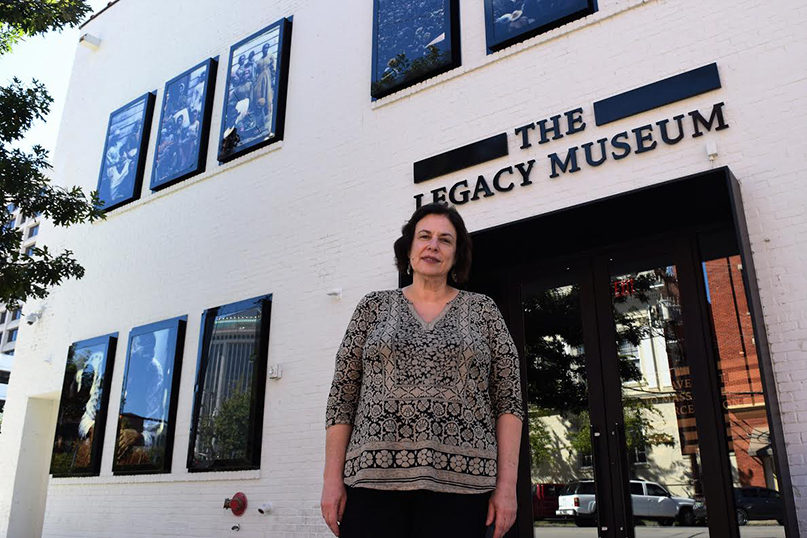
By Rabbi Debra Cantor
It’s a picture-perfect October day here on this hill overlooking the city of Montgomery. And it is here, in this bucolic setting, that we have come to remember one of the darkest, most horrifying parts of American history. The newly-opened National Memorial for Peace and Justice, and its accompanying Legacy Museum, is dedicated to tracing the connections between the enslavement of black people, through the racial terror of lynching, the humiliations of racial segregation and Jim Crow, the fight for civil rights, down to the racial inequity, injustice and mass incarceration of today.
We walk through the Memorial for two hours in complete silence. This place reminds us that there are sacred moments and experiences that are beyond words. Later, we will talk and share. We will begin to figure out how this trip will impact the social justice work we do, the way we teach, the alliances we need to form or strengthen back in our home communities.
We are a group of 35 rabbis, cantors and Jewish communal leaders from across the United States, brought together for this trip by the organization T’ruah, a network of over 2,000 rabbis and cantors from all streams of Judaism dedicated to bringing a Jewish moral voice to human rights. Fighting poverty, injustice, ending solitary confinement and mass incarceration have been central priorities of T’ruah’s work in recent years. But this is not simply a trip; it is a pilgrimage.
This place of memory is holy ground. I have been in spaces like this before. All of us have. One colleague later recalls his many trips to Yad Vashem, to the Holocaust Museum in Washington. “I recognize this kind of horror,” he says. “But, this was different. Because it didn’t happen across an ocean. It happened here. It didn’t happen to my people. I’m a Jew. And I’m white. And I’m an American. And racial injustice, it’s still happening.”
At the Memorial, a pathway leads up a hill to a structure built of over 800 six-foot steel monuments (each representing a location in the US where a racial terror lynching took place). Engraved on each monument are the names of the victims and the dates when the lynchings took place. The steel has been permitted to oxidize so that each monument takes on its own distinct patterns and shades of color. As we walk along the descending path inside, the steel monuments, suspended from the ceiling, begin to rise slowly overhead. The effect is overwhelming. There are so many monuments, so many, many names. The enormity of the tragedy is almost too much to comprehend. And there are thousands more terror victims whose names and stories will never be known.
And then, around the corner, on the sides of the walls, short placards tell the stories of 90 of the victims. These singular stories affect me most of all: Charlotte Harris, lynched after a white man’s barn burned down; Henry Smith, lynched before a mob of 10,000 people; David Hunter, lynched for leaving the farm where he was working without permission.
One of the last signs stops me in my tracks: Robert Mallard, a prosperous farmer, lynched near Lyons, Georgia, in 1948 for voting. And I think about all the efforts at voter suppression today. And the power of the vote.
Back at the hotel, we study Jewish texts about teshuvah, about taking responsibility for the sins of past generations. We wonder: To what degree are we responsible for what we have seen? None of us has ever lynched or enslaved anyone. Here in Connecticut, we were taught that slavery and overt racism was something that happened down south, though, as it turns out, much of Connecticut’s rich treasure was built on the backs of slaves. Even so, most Jews weren’t in America back then.
Yet, as one young lawyer who works for the Equal Justice Initiative, the organization which built the Museum and Monument, told us: “Just because you didn’t plant the tree doesn’t mean you don’t sit in its shade.” She herself is Jewish and she told us that part of what sustains her in the difficult work she does – defending indigent clients on death row, and those who have been mistreated by the justice system – are the Jewish values of justice, truth and humility.
As Jews, we know what it is to suffer discrimination. If we are white (and not all Jews are!), we also know what it means to take our privileges for granted. As Americans, we know what our country aspires to be. We are grateful that this country took our people in and allowed us to thrive. Many of our fellow Americans did not have that opportunity. We need to face that our country has a dark past which continues to cloud its present.
Today, we witness the growing resurgence, acceptance and even glorification of white supremacy and racism (along with antisemitism). The truth is, racism has always been here; it is baked into the DNA of our country. But, in the words of journalist and civil rights leader Ida B. Wells, “the way to right wrongs is to turn the light of truth upon them.” May we take up that challenge.
Rabbi Debra Cantor is spiritual leader of B’nai Tikvoh-Sholom in Bloomfield.
CAP: Rabbi Debra Cantor in front of The Legacy Museum in Montgomery, Alabama. Credit: Jill Friedman/Courtesy of T’ruah







 Southern New England Jewish Ledger
Southern New England Jewish Ledger













